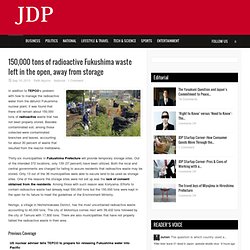

150,000 tons of radioactive Fukushima waste left in the open, away from storage. 150,000 tons of radioactive Fukushima waste left in the open, away from storage Sep 16, 2013 Faith Aquino National 1 Comment In addition to TEPCO’s problem with how to manage the radioactive water from the defunct Fukushima nuclear plant, it was found that there still remain about 150,000 tons of radioactive waste that has not been properly stored.

Besides contaminated soil, among those collected were contaminated branches and leaves, accounting for about 30 percent of waste that resulted from the reactor meltdowns. Thirty-six municipalities in Fukushima Prefecture will provide temporary storage sites. Out of the intended 372 locations, only 139 (37 percent) have been utilized. Nishigo, a village in Nishishirakawa District, has the most uncontained radioactive waste accounting to 40,000 tons. [via Yomiuri] Contamination, Disaster recovery, Environment, Fukushima, Pollution, Radiation, TEPCO, Tokyo Electric Power Co inShare0. Radioactive waste containers at a storage facility at Rokkasho-mura, Japan. Fukushima : le système de décontamination de l'eau à nouveau stoppé.
Comprendre la situation à Fukushima en deux minutes. De l’eau de pluie de Fukushima pourrait descendre dans l’océan Pacifique. Le société gérante de la centrale accidentée de Fukushima a annoncé lundi avoir pris des «mesures d'urgence» pour évacuer de l'eau de pluie accumulée sur le site à cause d'un violent typhon traversant le Japon.

Les fortes précipitations tombées depuis dimanche ont entraîné «une rapide montée du niveau d'eau» dans les différentes zones du complexe atomique où sont installés des réservoirs de stockage de liquide hautement radioactif. Pas plus de 30 becquerels par litre Ces zones sont entourées d'un petit muret. Pour que cette eau ne stagne pas trop longtemps au contact de réservoirs et d'un sol potentiellement contaminés, Tokyo Electric Power (Tepco) a expliqué avoir décidé, après avoir mesuré les niveaux de rayonnements de cette eau, d'en relâcher une partie, là où la teneur en strontium 90 ne dépasse pas 30 becquerels par litre.
Des vannes ont donc été ouvertes et l'eau va vraisemblablement descendre jusqu'à l'océan Pacifique voisin. Avec AFP Plus d'informations sur ce sujet en vidéo. TEPCO withheld data on contaminated well water for weeks. After finding tritium levels higher than the safety standard in well water at the crippled Fukushima No. 1 nuclear power plant, Tokyo Electric Power Co. withheld the information from the public for nearly three weeks. The company on June 19 disclosed that 500,000 becquerels of tritium per liter of water, eight times the legal limit, were detected. It also said that 1,000 becquerels of strontium, 30 times the legal limit, were detected. TEPCO began taking water samples from the well on the sea side of the turbine buildings for the No. 1 and No. 2 reactors on May 24. Analysis results about tritium were conveyed to plant officials on May 31 and shared within the company on June 14.
A TEPCO official said the announcement was not made until June 19 because additional analyses were carried out as there had been problems in past measurements. The official also said the company waited until June 18 to see analysis results about strontium, which were due that day. IAEA inspector backs pumping Fukushima groundwater into sea. VIENNA – A possible solution to the increasing amount of radioactive water inside the crisis-hit Fukushima No. 1 nuclear power plant could be to pump groundwater into the sea before it flows into the reactor buildings, as planned by the plant operator, the head of international inspectors has said.
“It will be very nice if they really get to bypass the main (buildings) through these systems — through this direct pumping of the water to the sea or whatever it is. Because it is clean water,” said Juan Carlos Lentijo, head of a 13-member team of the International Atomic Energy Agency that inspected the plant last month. Tokyo Electric Power Co. has created a system to direct part of the groundwater into the sea before it flows and seeps into the reactor buildings and mixes with highly radioactive water accumulating inside, increasing the amount by 400 tons a day, but has yet to win approval from local fishermen to discharge the water. Le stockage de l'eau contaminée de Fukushima de plus en plus problématique.
Radioactive Water Imperils Fukushima Plant. Kyodo News, via Associated Press Gray and silver storage tanks filled with radioactive wastewater are sprawling over the grounds of the Fukushima Daiichi plant.

Groundwater is pouring into the plant’s ravaged reactor buildings at a rate of almost 75 gallons a minute. It becomes highly contaminated there, before being pumped out to keep from swamping a critical cooling system. A small army of workers has struggled to contain the continuous flow of radioactive wastewater, relying on hulking gray and silver storage tanks sprawling over 42 acres of parking lots and lawns. AM - Fukushima nuclear plant struggles to contain contaminated water 03/05/2013. TONY EASTLEY: More than two years after the meltdowns at Fukushima, the plant's operator is dealing with a new crisis - millions of litres of contaminated water inside the complex.

TEPCO has confirmed to AM that groundwater is flooding into the plant's reactor buildings at the astonishing rate of 285 litres a minute. Once inside, the water quickly becomes highly contaminated and has to be stored in tanks which cover 17 hectares of the plant's grounds. But with those tanks close to capacity now, TEPCO has started to clear an adjoining forest to make more space to store the contaminated run-off. North Asia correspondent Mark Willacy reports from Tokyo. MARK WILLACY: It's TEPCO's curse - water. Fukushima Nuclear Plant Is Still Unstable, Japanese Official Says.